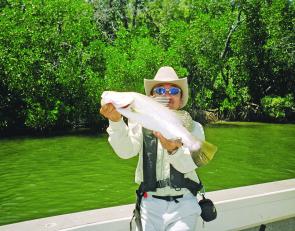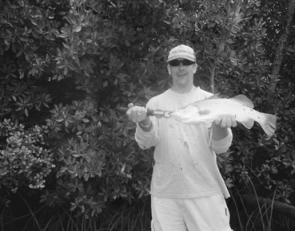The time of year is upon us when many wives and partners, once again, take on the role of the ‘fishing widow’. Fishy clothes need washing, lunches have to be packed and fishing gear will be strewn from one end of the house to the other – if you’re really lucky she will be right there with you!
The long awaited open to the barra season is here. The boats have been serviced, rods, reels and tackle have been checked and double checked and boat ramps are steadily filling as they once again start the hunt for that barra that will put them in the record books forever, or at least provide bragging rights over their mates.
As promised last month we are going to try to give you the good oil on where to head for your first barra.
Local and visiting land-based fishers in Townsville can improve their chances by using live baits. Live mullet and herring seem to be the current pick of baits but with good rain flushing numbers of prawns out of the creeks they will soon become the better option for anglers with the patience to use them. This is because smaller fish, not only barra, find prawns irresistible so larger fish baits should only see attention from trophy fish. Running rigs, either bridling or nose hooking these larger fish baits is a popular method that keeps your baits alive as water flows over their gills and also makes the baits look natural in the water.
If we do get good rain this month, as predicted, and the weirs start flowing from fresh water upper reaches anglers will find large numbers of barra stacked at the bottom of these structures. This is because it is the boundary between fresh and saltwater (Aplins Weir). Anglers will find that fish will push up to that wall in an attempt to get to the fresh water. They in turn feed on large schools of bait that come over the weir with the flood water and are forced to try and hide from predators. Anglers can take advantage of this by ‘matching the hatch’ and basically using the same bait that the fish are feeding on. Sounds simple, right?
For the small boat owner, try to look for junctions where two or more creeks meet. If there is a hole, snag or eddy close by use your sounder to check for fish and anchor to give yourself the best shot at placing a bait right on the nose of the fish. Anglers should find that almost any tidal creek, regardless of its size, will hold barra. Some will be easy to access while others will take a little more effort.
Remember the bigger the system and the harder it is to access the better the fishing! Fewer anglers mean more fish.
The same goes for those creeks that only have ocean access, but if you look on a navigation chart you will see a myriad smaller relatively unvisited locations that open up from their shallow entrances and hold quality fish. Remember ‘slow and steady’ until you are confident that you know your chosen creek.
For those anglers taking the challenge posed by the artificial bait, now is the time to dust off the tackle box and start practicing.
Shallow diving lures fished with a jerky retrieve, across the tops of mangrove lined mud bars, and at the top of larger tides have proven to be very effective techniques for many anglers. Effective lures are gold Bombers, Leads Highjackers, River2Sea Triho Mins, Thundersticks and another shallow runner with some metallic flash in the body colour. Many good barra will feed up in 2ft of water or less on the top of big tides.
At the bottom or falling part of the tide look for gutters, bends and snags that have bait in, near or around the structure as the barra will not be far away. Again a slow jerky retrieve micking an injured baitfish can be the best way to get a big lazy barra to eat your offering.
Soft plastics have made big inroads into the world of northern barra fishing and give anglers the option of jigging the edges of deep snags and holes where barra hold up at the bottom of the tides. It is only a matter of matching the jig head to the conditions (eg. how slow you want it to drop).
Basically anywhere that you can catch barra on bait, with the right technique and some persistence, you can also catch them on lures. I have found that slow trolling for big barra is the way to go whereas if you are chasing a hot session of smaller fish, hand casting is much more popular method. When trolling we tend to use larger deep diving lures to get down to the fish such as 150 Scorpions, River Rats, 150 Barra Classics or 6” Barra Baits in varying depths.
The news is all good for anglers who prefer the wide open bluewater with no more closures until the end of the year. In early January the coral trout fishing was a little slow but the redthroat emperor sessions have been red hot. Speaking of hot if the summer weather knocks you around too much, try fishing at night. This time of year you will see most of the big red emperor and large mouth nannygai being caught at night. Use the same baits and rigs at night that you normally would during the day and fish the same areas.
If you want to have your say about changes to the Fisheries Act 1994 grab a copy of The Queensland East Coast Inshore Fin Fish Fishery Questionnaire. You can get copies at your local tackle shop or by visiting www.dpi.qld.gov.au. They close on 7 February and really need your input. Some of the things they are looking at are changes to our size and bag limits for all inshore fish. Of the most concern to fishers is the commercial fishing industry wanting gill net yellow zones and the ban of cast nets as they are killing too many undersize fish. I wonder how many are killed by the trawling industry?
Hopefully everyone can get out for a fish this month, don’t take it to seriously – just enjoy it!
Reads: 1006
At the bottom or falling part of the tide look for gutters, bends and snags that have bait in, near or around the structure as barra, like these, will not be far away.

When trolling for barra we tend to use larger deep diving lures that get down to the fish such as 150 Scorpions, River Rats, 150 Barra Classics or 6” Barra Baits in varying depths.

The long awaited open to the barra season is here!




